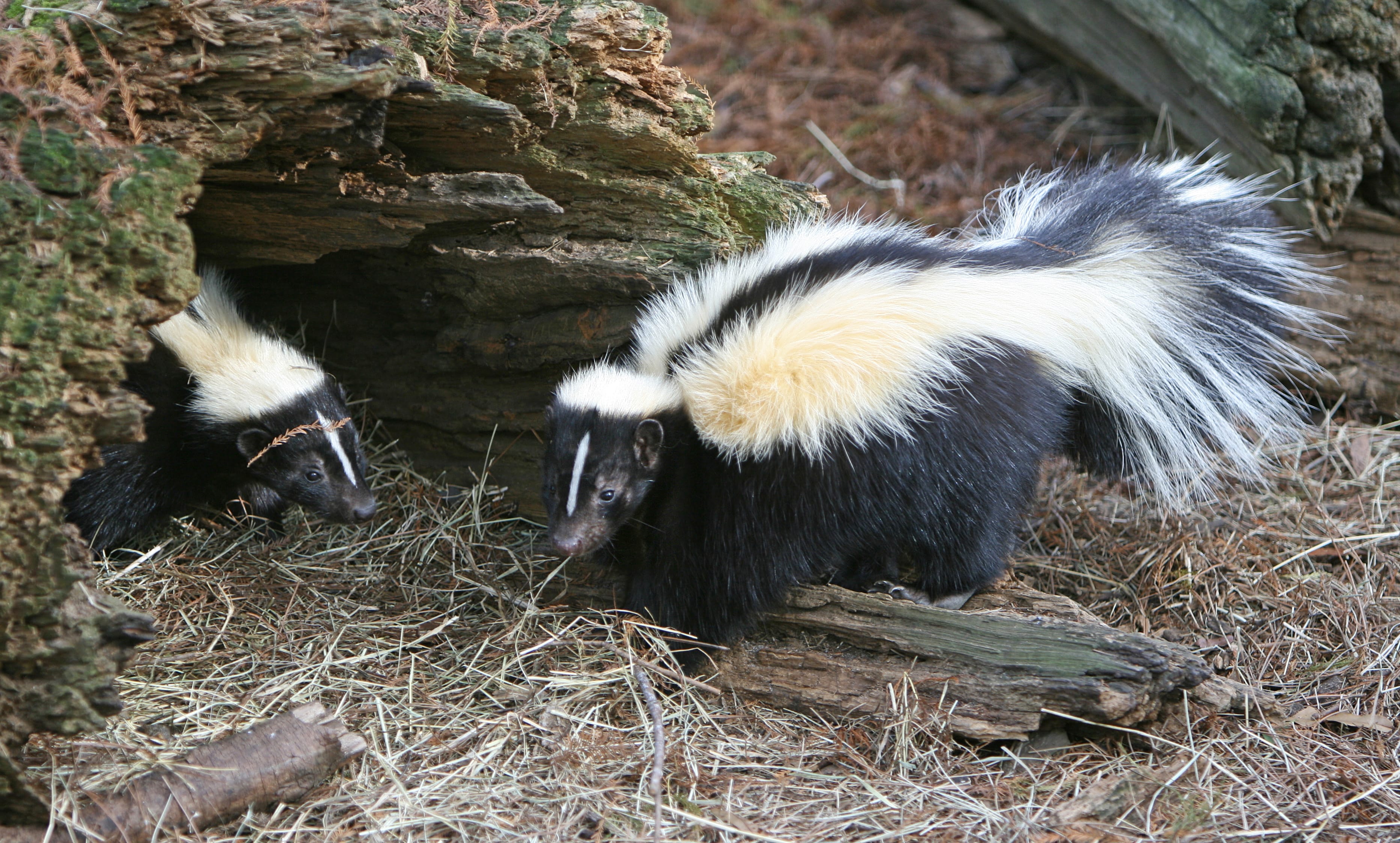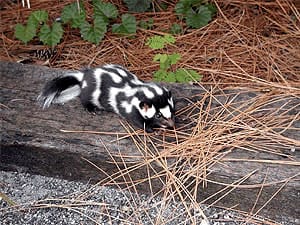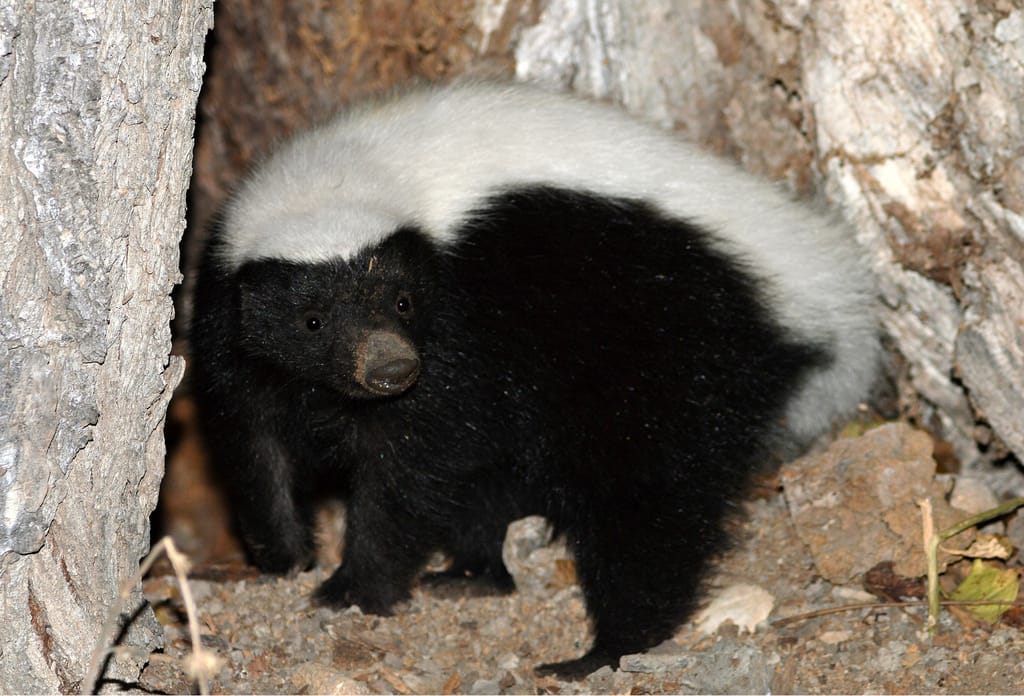Virginia is home to some of the most fascinating small mammals in North America — the skunks. Though they’re often remembered for their powerful scent defense, skunks in Virginia are far more than nature’s accidental pranksters. These creatures play vital roles in pest control, seed dispersal, and even soil aeration. In this guide, we’ll explore the 3 types of skunks in Virginia, including their physical traits, habits, diets, and how they interact with people. Whether you’ve spotted one crossing your backyard or heard them rustling through the woods at night, this article will help you identify and appreciate these black-and-white residents of the Old Dominion.
1. Striped Skunk (Mephitis mephitis)

Physical Characteristics & Identification Tips
The striped skunk is the most common and easily recognizable of all skunks in Virginia. Known for its bold black fur with a pair of white stripes that start from the head and run down the back, this species is hard to mistake for anything else. Adults typically measure between 20 and 30 inches in total length, including their thick, bushy tail. Males tend to be slightly larger than females, averaging around 6 to 10 pounds. Their small triangular heads, short legs, and long claws make them adept diggers — useful for finding insects or grubs under the soil.
When seen at night, the contrast of their fur often catches the light, and their slow, confident walk makes them appear almost casual. A useful tip for identifying a striped skunk at a distance is to look for that characteristic “V” pattern of white running down its back, along with its low-to-the-ground stance. If it starts to stamp its feet or raise its tail — that’s your cue to step back.
Behavior
Striped skunks are solitary animals, coming together only during the breeding season. They are nocturnal and spend most of the day sleeping in burrows or under sheds. Despite their reputation, they are not aggressive. They will give multiple warnings — hissing, foot-stomping, and tail-raising — before spraying. Their spray, made up of sulfur compounds, can reach up to 10 feet and is strong enough to deter even large predators like coyotes and foxes.
Interestingly, striped skunks are remarkably tolerant of humans. Many have adapted to suburban life, scavenging pet food, garden produce, or trash. While this sometimes leads to conflicts, they’re also natural pest controllers, feeding on beetles, crickets, and small rodents that would otherwise damage gardens and crops.
Habitat and Range
Across Virginia, striped skunks are found in nearly every county — from the coastal plains to the Appalachian foothills. They prefer open areas near woods, fields, and water sources. Unlike some mammals, striped skunks do not hibernate fully in winter. Instead, they enter a semi-dormant state, sleeping through the coldest spells but emerging occasionally on milder nights to forage.
Diet
Omnivorous and opportunistic, the striped skunk’s diet is seasonal and flexible. In summer, insects make up a large portion of their meals. In autumn and winter, they turn to fruits, nuts, and small mammals. They’re also known to raid bird nests, eat eggs, and dig up grubs from lawns. Their adaptable palate helps them thrive even in urban and suburban settings.
Reproduction and Life Cycle
Mating occurs from February through March, with females giving birth in late spring. A typical litter includes 4–6 kits. The young are born blind and helpless but grow quickly, venturing out with their mother by midsummer. By fall, they disperse to establish their own territories. A striped skunk in the wild usually lives two to three years, though they can survive longer in captivity.
Fun Facts / Unique Traits
- A striped skunk can spray up to six times before running out of its defensive fluid — after that, it may take over a week to replenish.
- Their spray isn’t just a deterrent; it’s so potent that even bears often avoid them.
- Despite their smell, skunks are surprisingly clean animals and groom themselves regularly like cats.
Human Interaction
Most encounters between people and striped skunks are accidental — a curious pet, a nighttime garbage raid, or a surprise under the porch. The best way to coexist is to secure trash cans, feed pets indoors, and seal openings around decks or sheds. If one happens to spray, a mixture of hydrogen peroxide, baking soda, and dish soap works better than tomato juice to neutralize the odor.
2. Eastern Spotted Skunk (Spilogale putorius)

Physical Characteristics & Identification Tips
The Eastern Spotted Skunk is smaller and more agile than its striped cousin, and arguably even more striking. Instead of broad stripes, it features broken white patches and spots across its sleek black coat. Adults weigh around 1 to 3 pounds and measure roughly 16 to 24 inches from nose to tail. The tail is fluffier relative to body size, giving it a somewhat “squirrel-like” appearance from a distance.
Identification tip: when alarmed, the Eastern Spotted Skunk often performs a handstand — balancing on its front paws while raising its tail high in the air. This unique behavior serves as a warning before spraying and is one of the most acrobatic defense displays in the animal kingdom.
Behavior
Unlike the slow-moving striped skunk, the spotted skunk is quick and nimble. It can climb trees, jump, and squeeze through tight gaps. These abilities help it evade predators and find food in surprising places, like old barns or hollow logs. It’s also less common to see, as this species prefers remote woodlands, rocky outcrops, or overgrown farmlands.
Eastern Spotted Skunks are mainly nocturnal and solitary. They rely on dens during winter, often reusing burrows made by other animals. Their activity peaks at dusk and dawn, and they’re far less likely to be seen in suburban areas than striped skunks.
Habitat and Range
Historically, the Eastern Spotted Skunk ranged across the eastern United States, including most of Virginia. However, populations have declined sharply over the past century, largely due to habitat loss, changes in farming practices, and pesticide use. Today, they’re most frequently found in southwestern and western Virginia, particularly in the Appalachian regions.
Diet
The Eastern Spotted Skunk is omnivorous but slightly more carnivorous than the striped skunk. It feeds on insects, small mammals, frogs, and even snakes. During summer, it supplements its diet with berries and nuts. Their appetite for rodents and crop pests makes them beneficial to farmers, though their elusive nature means they’re rarely seen at work.
Reproduction and Life Cycle
Breeding occurs in late winter. One fascinating trait is “delayed implantation,” where the fertilized egg remains dormant before developing — meaning babies are born later, typically in April or May. Each litter averages four to five kits. By late summer, the young are independent. Although their lifespan in the wild is short (around three years), their adaptability and stealthy habits help sustain their populations where suitable habitats remain.
Fun Facts / Unique Traits
- The handstand warning posture is one of nature’s most theatrical defense displays.
- They can climb trees, making them one of the few skunk species capable of arboreal movement.
- Their musky odor is less pungent than the striped skunk’s — but still powerful enough to make predators think twice.
Human Interaction
Eastern Spotted Skunks are considered a species of conservation concern in Virginia. Human encounters are rare, but landowners who maintain wooded edges and brush piles unknowingly help these animals by providing safe shelter. Farmers who minimize pesticide use also contribute to the skunk’s insect-rich diet. If spotted, it’s best to admire from a distance — they’re vital members of Virginia’s ecological balance.
3. Hog-Nosed Skunk (Conepatus leuconotus) — A Rare Visitor

Physical Characteristics & Identification Tips
While not officially resident in Virginia, the Hog-Nosed Skunk — also called the American Hog-Nosed Skunk — occasionally sparks curiosity among wildlife enthusiasts as a potential wanderer from farther south or west. This striking animal has a distinctive all-white back and tail, with the black fur restricted mainly to its sides and limbs. The name “hog-nosed” comes from its long, pig-like snout, which it uses to root through soil for insects and roots.
They are larger than other North American skunks, weighing up to 15 pounds. The combination of their pale dorsal fur and robust build makes them stand out even at night. Should a rare sighting occur in Virginia, it would almost certainly draw attention from naturalists and wildlife biologists alike.
Behavior
Hog-Nosed Skunks are nocturnal and solitary, much like other skunks. They’re more terrestrial, preferring to dig rather than climb. Their powerful forelimbs and elongated claws are perfect for unearthing beetle larvae and grubs. When threatened, they too rely on spraying, but often give loud snorts and ground-stomping warnings first — behavior that matches their bold look.
Habitat and Range
This species’ primary range includes parts of the southwestern United States, Mexico, and Central America. Occasional reports from further east are generally considered strays or misidentifications. However, climate shifts and changes in land use have occasionally led to isolated wanderers venturing beyond their typical range. If Virginia ever records one, it would likely be in the far western or southern counties, close to the Appalachian corridor.
Diet
The Hog-Nosed Skunk’s diet is dominated by insects, roots, and tubers. Its digging habits aerate the soil, similar to the way wild pigs do. In arid regions, they’ll also consume reptiles and fallen fruit. This flexible diet would allow them to adapt fairly well to Virginia’s environment if they ever establish a foothold.
Reproduction and Life Cycle
Breeding typically occurs in early spring. Females give birth to litters of 2–6 young after a gestation of about two months. The young are born blind and stay in the den for several weeks before following their mother on foraging trips. These skunks can live up to four years in the wild.
Fun Facts / Unique Traits
- They are named for their long snouts, which resemble those of domestic pigs.
- Unlike other skunks, the Hog-Nosed species has a single wide white stripe rather than two narrow ones.
- They are exceptional diggers — capable of overturning stones and ripping apart ant nests with ease.
Human Interaction
Encounters in Virginia are speculative but worth mentioning for educational purposes. Their ecological role as insect controllers could benefit local ecosystems, should any ever migrate this far east. If confirmed, such an occurrence would mark an exciting addition to the state’s mammalian fauna.
Conclusion
From the familiar Striped Skunk to the elusive Eastern Spotted Skunk — and even the possible wanderer, the Hog-Nosed Skunk — these animals form a small yet fascinating part of Virginia’s wildlife heritage. Each plays an important role in controlling pests and maintaining ecological balance. While their smell might not win them any popularity contests, skunks are remarkably gentle, curious, and vital creatures worth protecting.
If you happen to spot one, remember: keep your distance, appreciate from afar, and enjoy observing one of nature’s most misunderstood mammals. Hopefully, this guide to the Types of Skunks in Virginia helps you identify and respect these intriguing little neighbors the next time they waddle through your backyard.
Frequently Asked Questions About Skunks in Virginia
1. How many types of skunks live in Virginia?
Virginia is home to two confirmed species of skunks — the Striped Skunk and the Eastern Spotted Skunk. A third, the Hog-Nosed Skunk, is occasionally mentioned as a rare visitor but not officially recorded.
2. What is the most common skunk species in Virginia?
The Striped Skunk (Mephitis mephitis) is the most widespread and recognizable species found throughout Virginia’s rural and suburban areas.
3. Where can I see skunks in Virginia?
Skunks in Virginia are found in open fields, wooded edges, farmlands, and even suburban neighborhoods. They prefer areas close to water and shelter such as brush piles or old burrows.
4. Are skunks dangerous to humans or pets?
Skunks are not aggressive. They spray only when threatened. However, they can carry rabies, so it’s best to keep a safe distance and avoid contact.
5. What do skunks eat in Virginia?
Skunks in Virginia are omnivorous. Their diet includes insects, worms, berries, fruits, small rodents, and even bird eggs. They help control pests naturally.
6. When are skunks most active?
Skunks are nocturnal, meaning they’re most active during the night. You’ll often spot them around dusk or dawn searching for food.
7. Do skunks hibernate in Virginia’s winter?
Skunks don’t truly hibernate. Instead, they enter a semi-dormant state called torpor, sleeping through colder periods and emerging on milder nights to forage.
8. How can I tell the difference between a striped and spotted skunk?
The Striped Skunk has two broad white stripes down its back, while the Eastern Spotted Skunk displays small patches and broken white lines across its body.
9. Are Eastern Spotted Skunks endangered in Virginia?
Eastern Spotted Skunks are considered a species of conservation concern in Virginia due to habitat loss and declining populations in many regions.
10. How far can a skunk spray?
A skunk can accurately spray up to 10 feet and may release its scent multiple times before depleting its reserves.
11. What should I do if a skunk sprays near my house?
Ventilate the area immediately. To neutralize the odor, mix hydrogen peroxide, baking soda, and dish soap — it works better than tomato juice.
12. Do skunks climb trees?
Striped Skunks rarely climb, but Eastern Spotted Skunks are skilled climbers and can even scale trees to escape predators or find food.
13. How long do skunks live in the wild?
Most skunks in Virginia live about 2–3 years in the wild, though some may reach 5–6 years under favorable conditions.
14. What attracts skunks to my yard?
Unsecured trash, pet food, grubs in the lawn, and easy shelter under decks or sheds often attract skunks to residential areas.
15. How can I humanely keep skunks away from my property?
Seal gaps under porches, remove outdoor food sources, and use motion-activated lights or sprinklers. Skunks dislike strong lights and sudden noises.
16. What time of year do skunks have babies?
Skunk mating season in Virginia usually occurs in late winter. Females give birth in spring, typically to 4–6 kits that stay with the mother until autumn.
17. Do skunks make good pets?
In most states, including Virginia, it is illegal to keep wild skunks as pets. They are best appreciated in their natural habitats.
18. Why do skunks raise their tails before spraying?
Tail-raising is a warning sign. Skunks display this behavior to signal danger before releasing their defensive spray — it’s nature’s polite “back off.”
19. How can I identify skunk tracks?
Skunk tracks show five toes on each foot with visible claw marks. They look similar to raccoon tracks but are smaller and more compact.
20. What predators hunt skunks in Virginia?
Great horned owls, coyotes, foxes, and bobcats are known predators of skunks, though many animals avoid them due to their powerful scent defense.
21. Do skunks help the environment?
Yes. Skunks are beneficial because they eat insects, grubs, and rodents that can harm gardens and crops. They’re natural pest managers.
22. What should I do if I find a baby skunk alone?
Do not touch it. Observe from a distance. The mother is usually nearby. If it seems abandoned after several hours, contact a licensed wildlife rehabilitator.
23. Are there skunks in Northern Virginia suburbs?
Yes. Striped Skunks are common in Northern Virginia’s suburbs, while Eastern Spotted Skunks prefer more rural, wooded habitats in the west.
24. How do skunks communicate?
Skunks communicate through hisses, growls, foot-stomping, and body postures. Their scent marking also conveys territory boundaries.
25. Can skunks dig under fences?
Absolutely. Skunks are excellent diggers. To deter them, bury fencing at least 12 inches deep and angle it outward.
26. What is the rarest skunk in Virginia?
The Eastern Spotted Skunk is the rarest confirmed skunk species in Virginia. It’s elusive and primarily found in the Appalachian foothills.
27. Have Hog-Nosed Skunks ever been spotted in Virginia?
Official records are lacking, but some naturalists believe the Hog-Nosed Skunk could occasionally wander eastward. No verified sightings exist yet.
28. Do skunks carry diseases?
Yes. Like raccoons and foxes, skunks can carry rabies and parasites. Avoid handling them or their carcasses.
29. What should I do if my pet gets sprayed by a skunk?
Bathe your pet outdoors using a mix of hydrogen peroxide, baking soda, and dish soap. Rinse thoroughly and avoid contact with the eyes.
30. Do skunks make noises?
Yes, skunks make soft hisses, squeaks, or growls when threatened. Kits may chirp to call their mothers.
31. What time of year are skunks most visible?
Skunks are most visible in early spring and late summer when they are breeding or when young kits begin exploring.
32. How can I tell if a skunk is living under my shed?
Look for small holes, musky odors, and soil disturbance near foundations. Nighttime digging noises can also be a sign of a resident skunk.
33. Do skunks swim?
Yes, skunks can swim, but they prefer dry ground and will only enter water to escape predators or cross short distances.
34. Are skunks protected in Virginia?
Yes, they are classified as furbearers under Virginia law. Control or relocation should only be handled by licensed professionals.
35. Why are skunks important to Virginia’s ecosystems?
Skunks in Virginia help maintain ecological balance by controlling insect populations, aerating soil, and dispersing seeds through their droppings.
